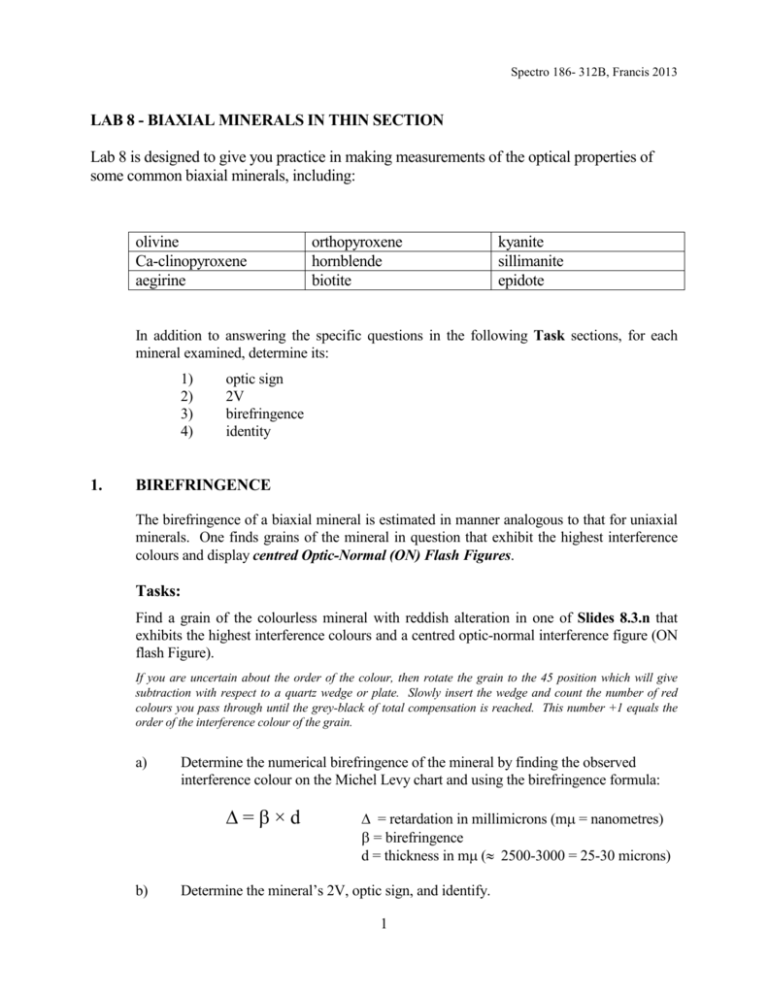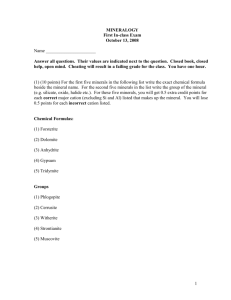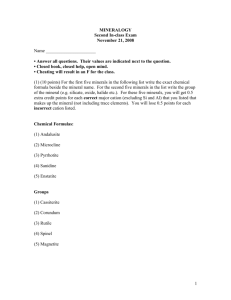OptLab8-13
advertisement

Spectro 186- 312B, Francis 2013 LAB 8 - BIAXIAL MINERALS IN THIN SECTION Lab 8 is designed to give you practice in making measurements of the optical properties of some common biaxial minerals, including: olivine Ca-clinopyroxene aegirine orthopyroxene hornblende biotite kyanite sillimanite epidote In addition to answering the specific questions in the following Task sections, for each mineral examined, determine its: 1) 2) 3) 4) 1. optic sign 2V birefringence identity BIREFRINGENCE The birefringence of a biaxial mineral is estimated in manner analogous to that for uniaxial minerals. One finds grains of the mineral in question that exhibit the highest interference colours and display centred Optic-Normal (ON) Flash Figures. Tasks: Find a grain of the colourless mineral with reddish alteration in one of Slides 8.3.n that exhibits the highest interference colours and a centred optic-normal interference figure (ON flash Figure). If you are uncertain about the order of the colour, then rotate the grain to the 45 position which will give subtraction with respect to a quartz wedge or plate. Slowly insert the wedge and count the number of red colours you pass through until the grey-black of total compensation is reached. This number +1 equals the order of the interference colour of the grain. a) Determine the numerical birefringence of the mineral by finding the observed interference colour on the Michel Levy chart and using the birefringence formula: =×d b) = retardation in millimicrons (m = nanometres) = birefringence d = thickness in m ( 2500-3000 = 25-30 microns) Determine the mineral’s 2V, optic sign, and identify. 1 Spectro 186- 312B, Francis 2013 2. PLEOCHROISM Pleochroism is the variation in colour or absorption of a mineral in plane polarized light upon rotation of the microscope stage. Unfortunately, the microscopes you use make even non-pleochroic minerals (such as quartz and feldspar) look slightly pleochroic, however, many minerals have very characteristic pleochroic colours. Tasks: a) Determine the true colours of N, N, and N in plane polarized light for the reddish brown pleochroic mineral in one of Slides 8.9.n. Determine the brown mineral’s birefringence, 2V, optic sign, and identity. b) Determine the true colours of N, N, and N in plane polarized light for the reddish brown pleochroic mineral in one of Slides MC-15 or MC-16. Determine the brown mineral’s birefringence, 2V, optic sign and identity. 3. SIGN OF ELONGATION Some minerals are characteristically length fast or length slow, while others may be either depending on the orientation of individual grains (such minerals have N closest to their direction of elongation). The sign of elongation of a mineral is determined by rotating an elongated grain to the 45 position and using an accessory plate to determine whether N' or N' is closest to the direction of elongation. Negative Elongation (length fast) The vibration direction closest to the long dimension of a mineral is N, that is, it has the smallest refractive index. Positive Elongation (length slow) The vibration direction closest to the long dimension of a mineral is N, that is, it has the largest refractive index. Unlike uniaxial minerals, in biaxial minerals the sign of elongation is not necessarily equal to the optic sign. Tasks: a) Determine the sign of elongation of the grey mineral of low birefringence in one of Slides MC-15 or MC-16. Determine this mineral’s birefringence, 2V, optic sign, and identity. b) Determine the sign of elongation of the green pleochroic mineral in one of Slides 8.7.n (be careful). Determine the green mineral’s birefringence, 2V, optic sign, and identity. Hint: note this mineral’s anomalous interference colour. 2 Spectro 186- 312B, Francis 2013 4. EXTINCTION ANGLE An extinction angle is the angle between one of a grain's principal vibration directions and a linear crystallographic feature. Possible linear features: - traces of cleavage planes - traces of crystal faces - traces of twin composition planes - long axis of crystals - crystallographic axes Types of Extinction: Parallel Extinction: The linear features, in question, coincide with one of the grain's vibration directions. The grain is extinct under cross-polars when the linear feature coincides with one of the microscope's cross hairs. This type of extinction is common in uniaxial and orthorhombic biaxial minerals. Symmetric Extinction: The grain's vibrational directions bisect angles between two symmetry related linear features. The grain is extinct when cross hairs bisect angles between the 2 linear features. This type of extinction is common in uniaxial and orthorhombic biaxial minerals. Inclined Extinction: The linear feature is at some angle to the grain's vibration directions. For example, when the grain is in an extinction position, the linear feature in question does not parallel the cross hairs. This is the general case for monoclinic and triclinic biaxial minerals. If an extinction angle is to be measured, 3 pieces of information must be known and specified along with the measured angle (continued overleaf): i) ii) iii) the orientation of the grain the crystallographic feature involved, (ie.; c axis, 00l cleavage trace, etc.) the vibration direction considered. 3 Spectro 186- 312B, Francis 2013 Typical Grain Orientations: Elongated Minerals: Typically, the c crystallographic axis parallels the long dimension of the crystal. One chooses a grain exhibiting maximum length, thus having c in the plane of the microscope stage. Monoclinic Minerals: Typically one uses grains whose b crystallographic axis is vertical. This requires that you know which of the mineral's three principle vibration direction parallels the b axis and the resultant interference figure that will be observed when b is vertical. Triclinic Minerals: Extinction angles are measured with respect to the trace of a cleavage or twin plane in grain in which the plane of the feature is vertical. To determine if a linear trace corresponds to a vertical plane, raise and lower the focus on the trace with the high-power objective. If the line does not exhibit horizontal movement, the plane producing the line is vertical. When dealing with an unknown mineral, it is usually sufficient to simply determine whether the mineral exhibits parallel, symmetric or inclined extinction. Actual extinction angles are typically measured only after the mineral has been identified in order to more precisely determine the mineral's composition. Measurement of Extinction Angles: To measure an extinction angle, one proceeds as follows: Choose a grain having the desired orientation, and rotate the stage until a linear feature parallels one of the microscope's cross hairs, and note the angle on the stage. Rotate to the nearest extinction position and note the angle of the stage. The extinction Angle is the difference between the measured angles. Identify the vibration direction coinciding with the cross hair used in step 2. In the general case, it will be either N' (N small) or N' (N big)). For grains exhibiting a principle section it will be one of: N, N or N. 4 Spectro 186- 312B, Francis 2013 Clinopyroxene versus Orthopyroxene Although they have different birefringences, optic signs, and 2V’s, the distinction between clinopyroxene and orthopyroxene in thin section is often best done on the basis of extinction angle: Orthopyroxene (orthorhombic) Orthopyroxenes have low birefringence and typically exhibit first-order interference colours. Most igneous orthopyroxenes have relative high 2V’s (60-90o) and are optically negative for En contents less than 88%. Orthopyroxenes typically exhibit parallel extinction – parallel traces of their cleavage planes (210) and/or their long dimension (c crystallographic axis [001]) are parallel to one of the microscopes cross-hairs (polarizer) at extinction. Orthopyroxenes often exhibit a fine lamellar (~0.002 mm in thickness) structure parallel to (100) and the c axis (and thus the length of the crystal) that may reflect insipient exsolution of clinopyroxene and/or twinning? Orthopyroxenes that exhibit simple (100) twins, with or without kinked clinopyroxene exsolution lamellae inclined to the long dimension of the crystal, have inverted from monoclinic pigeonite, with the cpx exsolution lamellae being parallel to (001) of the original pigeonite. Clinopyroxene (monoclinic) Clinopyroxenes have higher birefringence than orthopyroxene and commonly exhibit second-order interference colours. Ca-rich clinopyroxenes have moderate 2V’s (40-60o) and are optically positive. Low-Ca pigeonite is characterized by lower 2V’s (0-30o), whereas aegirine (NaFeSi2O6) is characterized by higher 2V’s (70o) and is optically negative. Clinopyroxenes generally exhibit inclined extinction. By convention, N corresponds to the b crystallographic axis in all clinopyroxenes. The actual extinction angle of any given clinopyroxene is a function of composition, and is typically measured on grains exhibiting an Optic-Normal Sections (maximum interference colours, N and thus b vertical). Commonly, the extinction angle between N and the c crystallographic axis (traces of the 110 cleavage or 100 parting are parallel to c for this orientation) is measured. Clinopyroxenes commonly exhibit simple twinning on (100), and multiple twins and/or exsolution lamellae of opx, pigeonite or even oxides on (001). 5 Spectro 186- 312B, Francis 2013 Orthopyroxene Clinopyroxene Tasks: a) Examine one of Slides: M-10, M-13, VD-604, VD-722, or VD-723. These slides contain 3 ferromagnesian minerals; olivine, orthopyroxene, and clinopyroxene. The turbid grey pyroxene grains can easily be distinguished from the clear olivine grains in plane polarized light. Distinguish between clinopyroxene and orthopyroxene grains on the basis of extinction angle, birefringence, optic sign, and 2V. Note and list any other distinguishing features of each type of pyroxene, such as twinning, exsolution, etc. Measure the maximum extinction angle in the clinopyroxene grains between the trace of the 110 cleavage plane and N. b) Examine the green pleochroic mineral in one of Slides 8.1.n What is the extinction type between the long axis of the mineral and the nearest vibration direction (be careful)? By observing a number of the longest grains, estimate the largest extinction angle observed between the long axis of the grains and the nearest vibration direction. What is this vibration direction? Determine the green mineral’s birefringence, 2V, optic sign, and identity. 6








